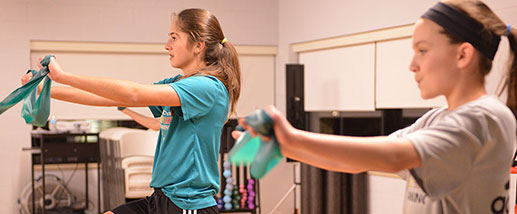Ten Running Tips to Prevent Injury and Improve Performance
January 30, 2024

Are you one of the estimated 50 million people in the U.S. who runs or jogs at least once a year? Whether you run for fun or are an ultramarathoner, following basic running tips could help improve your health and performance with the added benefit of avoiding injury.
Shown left to right: Marcus Schillaci, AT, ATC, CSCS, manager and Derek VandenBosch, CSCS, strength coach for Sports Performance and Rehab
For Beginners: Check with Your Primary Care Physician or Specialist
It is always a good idea to let your medical provider know about plans to take up a new sport or exercise regimen. This is because your provider might be able to offer resources of which you may not be aware. And if you have a pre-existing medical condition, such as asthma or heart disease, you definitely need to consult your medical provider. Your provider may weigh in on the best forms of exercise for you and the ways to ensure you do not put yourself at risk.
For Beginners: Plan a Sensible Progression
Many new runners make a common mistake: They feel good after running a short distance and then think they should immediately increase the distance or amount of time running to challenge themselves. The problem is that their joints and muscles may not be ready for a challenge. The best approach is to consult a trainer who can create a reasonable plan for you to do what you love without risking injury to your body. Your training progression should be gradual.
Buy Good Running Shoes
Running shoes fall into two categories: stability shoes or cushion shoes. It is important to choose the right shoes for your feet. You will want to purchase your running shoes from a store with employees who can help determine the best type of shoes for you and who know how to properly fit your shoes. If you choose the wrong shoes, it could lead to aches and pains that are preventable.
Cross-Train
Cross-training is doing something different than you normally do for exercise or training. Examples for a runner would be strength training using weights or balance training through yoga. Participating in a different sport is also considered cross-training. The idea is to do movements outside of your normal routine that will enable you to move in any direction with ease. Think of how you can get your body moving side-to-side, forward and backward, and in a rotating motion.
Cash In on the Benefits of Strength Training
- It reduces the risk of injury because your body is better prepared for exercise.
- It increases muscles, which burn more fat over time.
- It may improve your overall health.
- It can improve your running form.
- It may increase bone density.
Stay Hydrated
It is best to hydrate prior to exercise. If you are going to race, it is best to drink 16 oz. two hours before the race. You can hydrate during a race, too, especially in a long run. A drink with sodium, potassium, and carbohydrates is a little better than water.
Mix It Up
It’s best not to do the same thing every day. One day you could do a long run and the next a short run or sprint intervals. You could include a day of rest and then a day of strength training followed by a short run. Don’t do the same run every day.
Avoid Imbalance in Your Gait Mechanics
When you run with a phone or water bottle in one hand, you are changing your gait
to compensate for the weight of that item. The same holds true with items in your pocket. If you need to carry something with you while running, it is best to have it “rest” in the middle of the front or back of your body, perhaps in a hip bag or fanny pack.
Know How to Warm Up and Cool Down
Before running, it is good to perform a dynamic warm up by going through different functional movements such as walking lunges or toe touches. The best time to perform static stretching is after exercise, when you are ready to cool down your muscles and tendons. With static stretching, you hold a position without moving for a period of time.
Address Your Aches and Pains
One of the best ways to work out sore areas and to break up tightness is to do deep tissue massage. This can be done with a lacrosse ball or a foam roller. This massage is actually better than stretching when it comes to relieving tightness. Two areas that are commonly sore are the side of your quadricep above knee, and in your hip area above the glute.
With running season approaching, Trinity Health Michigan urges you to keep these tips in mind keep moving!





